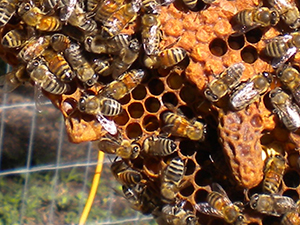
The biggest challenge I faced as a new beekeeper, and well into my beekeeping career, was splitting my colonies successfully. Some methods resulted in too few bees staying with the split. Some were not effective in preventing the bees from swarming. Even after I figured out how to make the split successful for both the parent colony and the split, often my timing was off and they swarmed anyway. Reading about all the types of splits and all those historic names can be confusing, hard to understand, and hard to remember. It is intimidating, but shouldn’t be. This method is easy to understand and to succeed with.
Our Goals, the Bees’ Goals
Keeping colonies from swarming is one of the most important jobs beekeepers have. One reason it is so difficult is because we are working against one of the most basic instincts of the honey bee. The goal of every creature is to reproduce itself, and the honey bee colony as a super-organism is no exception. The honey bee colony’s goal is to make more colonies of bees. It is not, actually, to make extra honey for humans.
Our goal as beekeepers is to help the bees do what they want to do, in a positive way. There are some very negative aspects of swarming. One is that when bees swarm, they often choose to move into your neighbor’s attic, costing the neighbor good money to have them removed, and making you and your bees an enemy. Another negative aspect of swarming is the fact that unmanaged colonies eventually collapse due to Varroa destructor. When you allow a swarm to proceed from your hives, you are allowing a mite bomb to grow somewhere near your apiary, and it will come back and cause the collapse of the colonies in which you have been working hard to keep the mites under control. The third negative aspect of swarming is that when the bees go, they take with them excess honey production for the season. The bees may manage to make enough for themselves, but there won’t be any for you.
Not only is swarming important for maintaining numbers of colonies in the world, it is an important action that helps keep varroa mite numbers lower, and improves colony survival. According to Dr. Tom Seeley, splitting colonies is as effective at improving mite control and survival as swarming is.1 This makes successfully splitting colonies as vitally important for them as it is for us.
Three Clues For You
Our first challenge is to learn to recognize the clues that tell us that the bees are preparing to swarm, so that we get our timing right. Splitting too early risks chilled brood, according to Dr. Meghan Milbrath.2 Splitting too late ensures that the swarm will still proceed. Every colony builds queen cups at all times of the year, and especially in the spring. The presence of one or two queen cups doesn’t mean anything. The secret clue that the bees are serious about swarming is the presence of many, many queen cups. Queen cups are just the empty start of a cell. Queen cells have eggs and larvae in them. Our goal is to split the hive before queen cups become queen cells. Also remember that not only do swarm cells occur on the bottoms of frames, but everywhere that the bees consider an edge. This means that in the center of the frame where the comb is not fully drawn, the bees may place swarm cells, since to them, it is an edge.
Step two in the bees’ progress toward swarming is the production of lots of drones. I mean lots of drones. When we inspect our colonies, we normally see drones here and there, but when we begin seeing what looks like a million drones, that is our clue. The bees seem to know that during swarm season, neighboring queens need drones to mate with that are almost three weeks older than they are,3 and so this is part of their preparation. Drone cells can be in the ladders between frames, along edges of comb, and in drone comb or honey comb at the edge of the brood nest. Adult drones can often be found on the first and last few frames of a colony where they are preparing for flights and staying out of the way of nurse bees.
Step three in their preparations to swarm is to slim down the queen. A good, productive queen has a huge abdomen, and she usually can’t fly very well. The queen’s attendants reduce the amount of food they give her, and thus reduce the amount of eggs she can lay.4 When she lays fewer eggs, her abdomen slims down, and she loses weight, enabling her to fly. They also chase and harass her, in essence, forcing her to exercise to get in shape.
I always begin seeing nectar in the brood chamber right before the colony swarms, even when plenty of space is available in honey supers. Whether this is done purposely by the bees in order to further reduce the queen’s laying capacity, or whether it is done in response to the already reduced egg laying of the dieting queen, we do not know. Dr. Larry Connor told me he believes that it is preparation for the resumption of brood rearing. At any rate, the final clue to spur you to action is seeing nectar in the brood chamber.
Not Too Early and Not Too Late
When the bees have completed steps one and two, there is usually a large population of bees, so that you can proceed with a split without worrying about chilled brood. When there is also a nice nectar and pollen flow coming in, they are ready to produce some well-fed baby queens. Now is the time to
….


